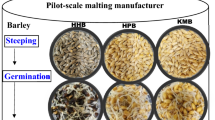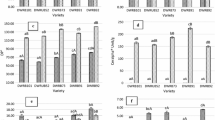Abstract
Cereals for beer brewing have long been dominated by barley (Hordeum vulgare) and wheat (Triticum aestivum). Tritordeum, a novel amphiploid hybrid of South American barley (Hordeum chilense) and durum wheat (Triticum turgidum), is considered an interesting alternative. The aim of the study was to investigate how different malting regimes influence the malt quality of tritordeum from a beer brewing perspective. Tritordeum malt produced by a double wet steep regime with 6 days of germination exceeded commercial barley malt in amylase activity and free amino nitrogen content (FAN) while achieving equal levels of extract. A triple wet steep regime was not as successful, only yielding an increase in β-glucanase activity. FAN, extract, acidity and amylase activity in tritordeum sweet worts generally increased with germination, with all quality parameters except β-amylase activity plateauing after 5 days. Worts made from tritordeum malts generally had higher iron levels than worts made from the barley malt. A laboratory-scale brew of the best experimental tritordeum malt had the same alcohol content as the barley malt reference, confirming its potential as an alternative raw material. Elevated FAN and iron contents were retained throughout the brewing process.


Similar content being viewed by others
References
Alfeo V, De Causmaecker B, Goiris BJ, Aerts G, Planeta D, Todaro A (2018) Preliminary evaluation of durum wheat (Triticum Turgidum Subsp Durum) during malting process. Cereal Chem 95:312–319. https://doi.org/10.1002/cche.10032
Meussdoerffer F, Zarnkow M (2009) Starchy raw materials. In: Esslinger HM (ed) Handbook of brewing: processes, technology, markets. Wiley-VCH Verlag GmbH & Co. KGaA, Weinheim, pp 43–83. https://doi.org/10.1002/9783527623488.ch2
Martín A, Alvarez JB, Martín LM, Barro F, Ballesteros J (1999) The development of tritordeum: a novel cereal for food processing. J Cereal Sci 30:85–95. https://doi.org/10.1006/jcrs.1998.0235
Pujadas Salvà AJ (2017) × Tritordeum martinii A. Pujadas (Poaceae) nothosp. nov. × Tritordeum martinii A. Pujadas (Poaceae) nothosp. nov. Acta Bot Malacit 41:325. https://doi.org/10.24310/Actabotanicaabm.v41i0.2486
Villegas D, Casadesús J, Atienza SG, Martos V, Maalouf F, Karam F, Aranjuelo I, Nogués S (2010) Tritordeum, wheat and triticale yield components under multi-local mediterranean drought conditions. Field Crop Res 116:68–74. https://doi.org/10.1016/j.fcr.2009.11.012
Yousfi S, Serret MD, Voltas J, Araus JL (2010) Effect of salinity and water stress during the reproductive stage on growth, ion concentrations, Δ13C, and δ15N of durum wheat and related amphiploids. J Exp Bot 61:3529–3542. https://doi.org/10.1093/jxb/erq184
Aranjuelo I, Cabrera-Bosquet L, Araus JL, Nogués S (2013) Carbon and nitrogen partitioning during the post-anthesis period is conditioned by N fertilisation and sink strength in three cereals. Plant Biol 15:135–143. https://doi.org/10.1111/j.1438-8677.2012.00593.x
Asseng S, Ewert F, Martre P, Rötter RP, Lobell DB, Cammarano D, Kimball BA, Ottman MJ, Wall GW, White JW, Reynolds MP, Alderman PD, Prasad PVV, Aggarwal PK, Anothai J, Basso B, Biernath C, Challinor AJ, De Sanctis G, Doltra J, Fereres E, Garcia-Vila M, Gayler S, Hoogenboom G, Hunt LA, Izaurralde RC, Jabloun M, Jones CD, Kersebaum KC, Koehler A-K, Müller C, Naresh Kumar S, Nendel C, O’Leary G, Olesen JE, Palosuo T, Priesack E, Eyshi Rezaei E, Ruane AC, Semenov MA, Shcherbak I, Stöckle C, Stratonovitch P, Streck T, Supit I, Tao F, Thorburn PJ, Waha K, Wang E, Wallach D, Wolf J, Zhao Z, Zhu Y (2015) Rising temperatures reduce global wheat production. Nat Clim Chang 5:143–147. https://doi.org/10.1038/nclimate2470
Zdaniewicz M, Pater A, Hrabia O, Duliński R, Cioch-Skoneczny M (2020) Tritordeum malt: An innovative raw material for beer production. J Cereal Sci 96:103095. https://doi.org/10.1016/j.jcs.2020.103095
Bryce JH, Goodfellow V, Agu RC, Brosnan JM, Bringhurst TA, Jack FR (2010) Effect of different steeping conditions on endosperm modification and quality of distilling malt. J Inst Brew 116:125–133. https://doi.org/10.1002/j.2050-0416.2010.tb00408.x
Farzaneh V, Ghodsvali A, Bakhshabadi H, Zare Z, Carvalho IS (2017) The impact of germination time on the some selected parameters through malting process. Int J Biol Macromol 94:663–668. https://doi.org/10.1016/j.ijbiomac.2016.10.052
Poreda A, Bijak M, Zdaniewicz M, Jakubowski M, Makarewicz M (2015) Effect of wheat malt on the concentration of metal ions in wort and brewhouse by-products. J Inst Brew 121:224–230. https://doi.org/10.1002/jib.226
Wietstock PC, Kunz T, Waterkamp H, Methner FJ (2015) Uptake and release of Ca, Cu, Fe, Mg, and Zn during beer production. J Am Soc Brew Chem 73:179–184. https://doi.org/10.1094/ASBCJ-2015-0402-01
Bromberg SK, Bower PA, Fehring J, Gerber L, Lau VL, Tata M (1997) Requirements for Zinc, Manganese, Calcium in wort. J Am Soc Brew Chem 55:123–128. https://doi.org/10.1094/ASBCJ-55-0123
Poreda A, Antkiewicz P, Tuszyński T, Makarewicz M (2009) Accumulation and release of metal ions by Brewer’s yeast during successive fermentations. J Inst Brew 115:78–83. https://doi.org/10.1002/j.2050-0416.2009.tb00347.x
Zufall C, Tyrell T (2008) The influence of heavy metal ions on beer flavour stability. J Inst Brew 114:134–142. https://doi.org/10.1002/j.2050-0416.2008.tb00318.x
Hopulele T, Piendl A (1973) Effect of barley variety, environment, and malting technology on the mineral substances of malt. Proc Annu Meet Am Soc Brew Chem 31:75–83. https://doi.org/10.1080/00960845.1973.12006006
Hämäläinen JJ, Reinikainen P (2007) A simulation model for malt enzyme activities in Kilning. J Inst Brew 113:159–167. https://doi.org/10.1002/j.2050-0416.2007.tb00273.x
Reynolds T, MacWilliam IC (1966) Water uptake and enzymic activity during steeping of barley. J Inst Brew 72:166–170. https://doi.org/10.1002/j.2050-0416.1966.tb02947.x
European Brewing Convention (2010) Analytica-EBC, 9th edn. Hans Carl Getränke-Fachverlag, Nürnberg
Swanston JS, Taylor K (1990) The effects of different steeping regimes on water uptake, germination rate, milling energy and hot water extract. J Inst Brew 96:3–6. https://doi.org/10.1002/j.2050-0416.1990.tb01009.x
Reeves SG, O’Farrell DD, Wainwright T (1980) The effect of increased steeping temperature on malt properties. J Inst Brew 86:226–229. https://doi.org/10.1002/j.2050-0416.1980.tb06872.x
De Sá RM, Palmer GH (2004) Assessment of enzymatic endosperm modification of malting barley using individual grain analyses. J Inst Brew 110:43–50. https://doi.org/10.1002/j.2050-0416.2004.tb00179.x
Pohl P, Prusisz B (2010) Chemical fractionation of Cu, Fe and Mn in canned Polish beers. J Food Compos Anal 23:86–94. https://doi.org/10.1016/j.jfca.2009.08.002
Shaluk D, Bazin S, Chepurna A, Izydorczyk MS (2019) Effects of variable grain hydration during steeping on the content and physicochemical properties of non-starch polysaccharides in malt and wort. Food Res Int 116:430–440. https://doi.org/10.1016/j.foodres.2018.08.058
Rakha A, Saulnier L, Åman P, Andersson R (2012) Enzymatic fingerprinting of arabinoxylan and β-glucan in triticale, barley and tritordeum grains. Carbohydr Polym 90:1226–1234. https://doi.org/10.1016/j.carbpol.2012.06.054
Evans DE, Li C, Eglinton JK (2009) The properties and genetics of barley malt starch degrading enzymes. In: Zhang G, Chengdao L (eds) Genetics and improvement of barley malt quality. Advanced topics in science and technology in China. Springer, Berlin, Heidelberg, pp 143–189. https://doi.org/10.1007/978-3-642-01279-2_6
Holzmann A, Piendl A (1977) Malt modification and mashing conditions as factors influencing the minerals of wort. J Am Soc Brew Chem 35:1–8. https://doi.org/10.1094/ASBCJ-35-0001
Jaskula-Goiris B, De Causmaecker B, De Rouck G, De Cooman L, Aerts G (2011) Detailed multivariate modeling of beer staling in commercial pale lagers. Brew Sci 64:119–139
Wietstock PC, Kunz T, Methner F-J (2016) Relevance of oxygen for the formation of strecker aldehydes during beer production and storage. J Agric Food Chem 64:8035–8044. https://doi.org/10.1021/acs.jafc.6b03502
Acknowledgements
We thank Agrasys (Barcelona, Spain) for providing us with the raw tritordeum and tritordeum malt used in this study.
Funding
This work was supported by European Union’s Horizon 2020 research and innovation program under the Marie Skłodowska-Curie grant agreement No. 722166 (ITN EJDFoodSci).
Author information
Authors and Affiliations
Corresponding author
Ethics declarations
Conflict of interest
The authors declare that they have no conflict of interest.
Compliance with ethics requirements
This article does not contain any studies with human or animal subjects.
Additional information
Publisher's Note
Springer Nature remains neutral with regard to jurisdictional claims in published maps and institutional affiliations.
Contribution for the Special Issue: The chemistry behind malt and beer production—from raw material to product quality.
Rights and permissions
Springer Nature or its licensor holds exclusive rights to this article under a publishing agreement with the author(s) or other rightsholder(s); author self-archiving of the accepted manuscript version of this article is solely governed by the terms of such publishing agreement and applicable law.
About this article
Cite this article
Yding, E.D., Pagenstecher, M., Trummer, J. et al. Effect of malting regimes on the malt quality of tritordeum for beer brewing. Eur Food Res Technol 249, 95–102 (2023). https://doi.org/10.1007/s00217-022-04136-2
Received:
Revised:
Accepted:
Published:
Issue Date:
DOI: https://doi.org/10.1007/s00217-022-04136-2




